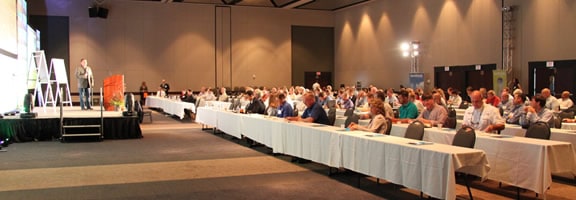The LANDTHINK Summit, a great one-day event held in Duluth, Ga. on September 29th brought together Timber Real Estate Investment Trusts (REITs), Timber Investment Management Organizations (TIMOs), land brokers, auction companies and land consultants to discuss economics, taxes and major trends in the land industry. This conference excelled at intensity, information and opportunities to network with land industry experts and decision makers.
LANDTHINK, led by Ryan Folk, immediately set the tone with a satirical view of the land industry. They presented a 10-minute video that questioned why there is so much interest in land with adequate doses of self-deprecating humor. The fact is land is the common denominator that attracted the interest of individuals and companies to travel from as far as Oregon, Oklahoma, Indiana and the Southeastern United States.
Black Swans of Global Economy
The summit’s keynote speaker, Dr. David Kohl, Professor Emeritus, Agriculture and Applied Economics from Virginia Tech covered mega-trends in the global economy, and U.S. farm real estate values that were delivered with a “Sunday go’in to meeting” enthusiasm. Megatrend influencers affecting the world economy include such “black swans” as oil, Japan’s recovery from natural disasters, sovereign debt issues and social unrest.
As oil exceeds $125 per barrel correlating to $4 per gallon, the analysis suggests U.S. consumers shutting down. Six of eight recessions in past the fifty years are due to oil prices. Seventy percent and sixty percent of oil and fertilizer produced respectively are in military/politically sensitive areas. Oil, water and agriculture production will be at the core of megatrends.
Timberland Professionals
In between sessions and lunch, the networking opportunities were remarkable. As a follower of the timberland industry, I was glad to meet representatives from two of the four REITs, Raynoir and Plum Creek and enjoyed our conversation about the ways the economy is affecting their business model. I also talked with representatives from American Forest Management, a TIMO who manage timberland from acquisition, forest consulting and conservation to sale.
I found the presentations by Dr. Tamara Cushing, Assistant Professor & Extension Forestry Specialist at Clemson University and Dr. Brooks Mendell, Principal for Forisk Consulting in Athens, Ga., to be especially useful. Dr. Cushing spoke on the topic of “Discovering the hidden costs of land ownership” while Dr. Mendell discussed “Forests, fuel and finance: global trends influencing bioenergy markets and timberland investments”. Each highlighted the tax consequences of timberland ownership and global factors driving wood bioenergy markets and affect on forest use and timberland values. These topics were relevant given the economic recession and planning horizon of forest landowners.
Housing Market and Banking
In addition to the discussion on economic trends and forest economics, presenters spoke about the housing market and how local banks approve real estate loans under oppressive regulation. John Hunt, President of ViaSearch & SmartNumbers provided an in-depth perspective of the Atlanta housing market. He talked about “the ring of death,” a circle outside Atlanta where developer lots sit foreclosed representing a 66 year inventory. One in seven homes is new versus four in seven prior to 2007. Mr. Kim Childers, President and Chief Credit Officer for State Bank Financial Corporation explained the difficulty of dealing with non-performing real estate loans, FDIC regulations and health of the banking industry. Insolvent banks are being closed and assets sold for pre 2004 values. It is not a pretty picture but necessary in the long term.
The LANDTHINK Staff, summit partner AgSouth Farm Credit and sponsors contributed valuable resources elevating a forum that like-minded land industry professionals found well worth their time.
This content may not be used or reproduced in any manner whatsoever, in part or in whole, without written permission of LANDTHINK. Use of this content without permission is a violation of federal copyright law. The articles, posts, comments, opinions and information provided by LANDTHINK are for informational and research purposes only and DOES NOT substitute or coincide with the advice of an attorney, accountant, real estate broker or any other licensed real estate professional. LANDTHINK strongly advises visitors and readers to seek their own professional guidance and advice related to buying, investing in or selling real estate.










Add Comment